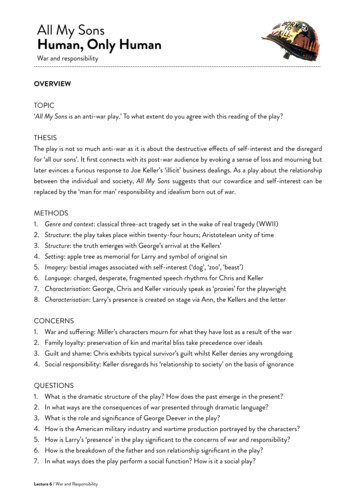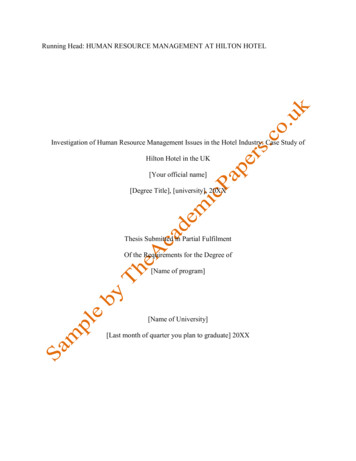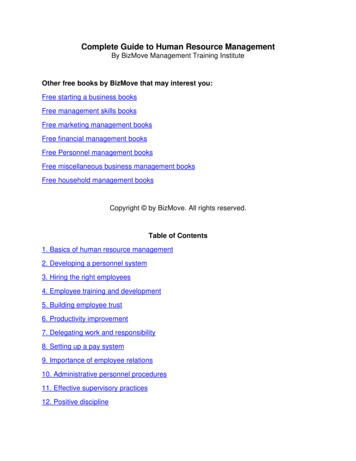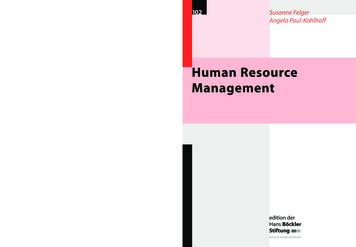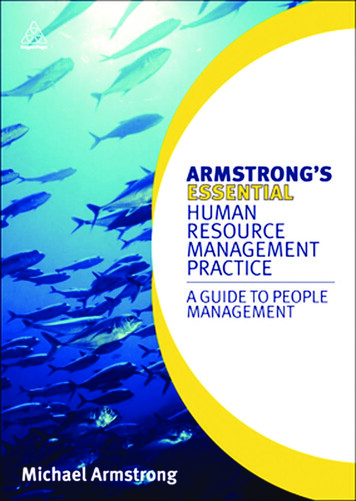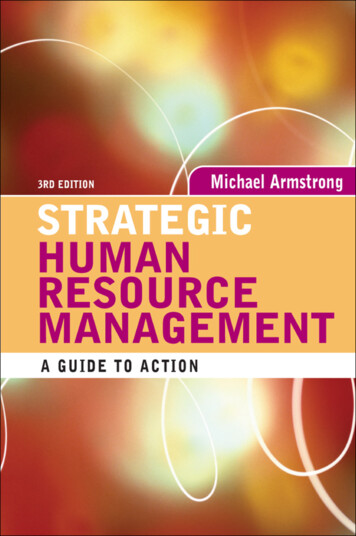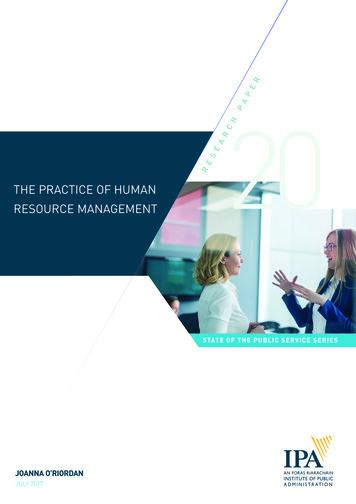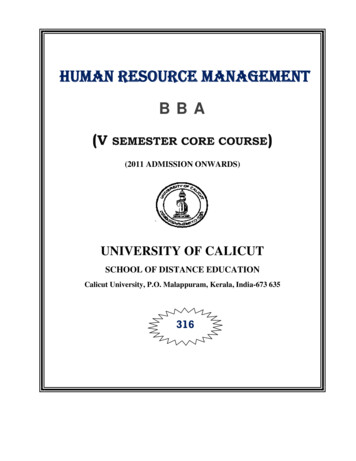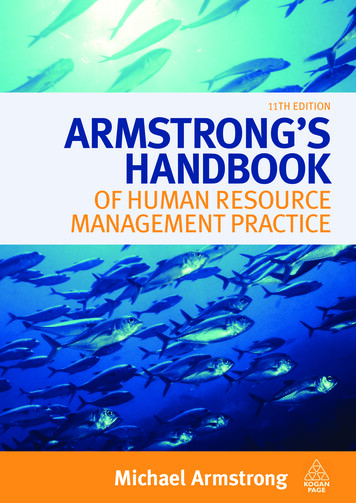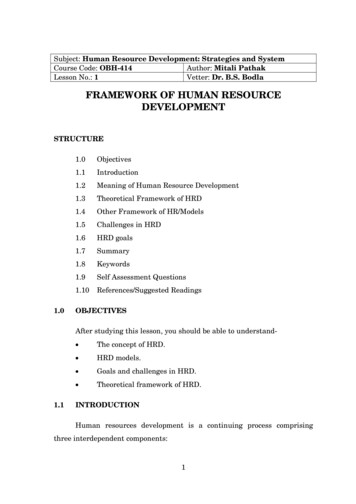
Transcription
Subject: Human Resource Development: Strategies and SystemCourse Code: OBH-414Author: Mitali PathakLesson No.: 1Vetter: Dr. B.S. BodlaFRAMEWORK OF HUMAN roduction1.2Meaning of Human Resource Development1.3Theoretical Framework of HRD1.4Other Framework of HR/Models1.5Challenges in HRD1.6HRD goals1.7Summary1.8Keywords1.9Self Assessment Questions1.10References/Suggested ReadingsOBJECTIVESAfter studying this lesson, you should be able to understand-1.1 The concept of HRD. HRD models. Goals and challenges in HRD. Theoretical framework of HRD.INTRODUCTIONHuman resources development is a continuing process comprisingthree interdependent components:1
ilities. Utilisation of those human resources to produce increasedoutput. Participation of the human beings who have improved resources(better education, better skills levels etc.) in the consumption ofthat increased output through a better quality of life. (See fig1.1)Investment inHuman ResourcesUtilisation of humanresources to increaseoutputEnhancement ofproductivecapabilitiesFig 1.1Sustainable human resources development must involve all threecomponents, as seen in the diagram above. At a national level, investment inhuman resources must be turned into effective utilisation of those humanresources if national output is to be increased on a sustainable basis.At an individual level, investment in human resources improvesearning capabilities. Therefore individuals and families have more money todo many things including pay for their own further skills development. Thereis a very strong link between investing inhuman resources development andimprovements in the quality of life. Improvements in nutrition, health andeducation are key elements of an improved quality of life and must beconsidered important investments in human resources, particularly in2
developing countries. Human beings cannot be developed if they do not haveenough food, are in poor health or cannot read or write. For developingcountries, it is extremely important that all members of the society haveaccess to human resource development activities, especially the poor, womenand populations in rural areas.Participation and choice are key elements in this view of humanresource development. The financial reward obtained from participation inproduction activity is the main way that individuals are able to participate inthe quality-of-life benefits that are created by development. Increased jobsatisfaction and a sense of personal worth arising from increased productivityare also very important contributions to quality of life. The enhancedcapabilities created by development enlarge the choices made available toboth individuals and nations.Historically, HRD has referred to developing human resources in orderto increase economic productivity and therefore a nation’s wealth, that is,very closely linked with economic outputs. However, within currentdefinitions and discussions, especially in the context of developing countries,there is more emphasis on the human aspects of HRD. So, in the developmentcontext the meaning of the term’s human resources development and humandevelopment are very much interconnected.1.2MEANING OF HUMAN RESOURCE DEVELOPMENTAccording to the American Society of Training and Development(ASTD), HRD is the integrated use of training and development,organizational development, and career development to improve individualgroup, and organizational effectiveness. Society ‘is faced with new challengesand changes daily which increases the need to provide employees withappropriate learning experiences. Moreover, HRD helps organizations toprovide learning related to the goals of the organization and to its employees.3
This learning is accomplished by providing training, education, anddevelopment.According to Leonard Nadler, author of Developing Human Resources, Training is a learning activity provided by employers toemployees, to help them perform, their current jobs moreefficiently; Education focuses on learning designed to prepare an individualfor a job different than the one currently held; and Development focuses on providing knowledge or skills within aspecified area, but is not necessarily job related.1.3THEORETICAL FRAMEWORK OF HRDThe Human Resource Development as a Function has evolved in Indiavery indigenously from the year 1975 when Larsen & Toubro Companyconceptualized HRD as an integrated system and decided to separate it fromPersonnel. Since then, in the last 25 years most organizations have elandotherdepartments as HRD Departments. Today there are high expectations fromHRD. Good HRD requires well structured function and appropriatelyidentified HRD systems, and competent staff to implement and facilitate thechange process.In 1975 Larsen & Toubro a prominent Engineering Company in Indiahad appointed two consultants from the Indian Institute of Management,Ahmedabad to study the performance appraisal system and makerecommendations for improving it. The two consultants (Pareek and Rao,1975) studied the system through interviews etc, and suggested a newsystem. Pareek and Rao (1975) recommended that “. Performance Appraisal,Potential Appraisal, Feedback and Counselling, Career Development andCareer Planning and Training and Development get distinct attention as4
unique parts of an integrated system which we call the Human ResourcesDevelopment System”. Pareek and Rao (1977) in their second report of theHuman Resources system in L&T recommended that the personnel functionbe viewed as Human Resources Function (HRF) and suggested a trifurcatedfunction: Personnel Administration, HRD and Worker Affairs.The consultants differentiated the HRD from other components of HRFand also integrated structurally and system-wise. Structurally the HRD is tobe a subsystem of HRD and integration of this with the other two subsystems(Personnel Administration and Worker Affairs) to be done by the Directorlevel person (for example Vice-President Personnel & HRD), through taskforces and sub-system linkages. Inter system linkages were outlined betweenvarious HRD subsystems to have an integrated system. The principlesdesigned deal with both the purpose of HRD systems and the process of theirimplementation. Some of these principles include:1.HRD systems should help the company to increase enablingcapabilities. The capabilities outlined in their report include:development of human resources in all aspects, organizationalhealth, improvements in problem solving capabilities, diagnosticskills, capabilities to support all the other systems in thecompany, etc;2.HRD systems should help individuals to recognize theirpotential and help them to contribute their best towards thevarious organizational roles they are expected to perform;3.HRD systems should help maximize individual autonomythrough increased ion and shared responsibility;5decentralizationthrough
5.HRD systems should facilitate participative hecurrentorganizational culture with changing culture; and7.There should be a continuous review and renewal of thefunction. In sum, the Integrated HRD systems approach ofPareek and Rao (1975) has the following elements:(i)A separate and differentiated HRD department with fulltime HRD staff.(ii)Six HRD subsystems including OD,(iii)Inter-linkages between the various subsystems,(iv)linked to other subsystems of Human Resource Function.After L&T accepted these recommendations in full andstarted implementing the State Bank of lndia the singlelargest Indian Bank and its Associates have decided touse the Integrated HRD systems approach and decided tocreate new HRD Department. Since then, by mid eightiesa large number of organizations in India have establishedHRD Departments.1.4OTHER FRAMEWORK OF HR/MODELSAs HRD came to prominence in the last decade, other frameworks andmodels came into existence. Some of these are briefly reviewed here.The Strategic HR Framework Approach. This framework formulated byUlrich and Lake (1990) aims to leverage and/or align HR practices to buildcritical organizational capabilities that enable an organization to achieve itsgoals. This framework offers specific tools and paths to identify how a firm6
can leverage its HR practices. Business strategy, organizational capabilitiesand HR practices are the three important elements in this framework.The Integrative Framework. The integrative framework offered byYeung and Berman (1997) identifies three paths through which HR practicescan contribute to business performance:(1)by building organizational capabilities;(2)by improving employee satisfaction; and(3)by shaping customer and share holder satisfaction.Yeung and Berman (1997) argued for dynamic changes in HRmeasures to refocus the priorities and resources of the HR function. Theyargued that HR measures should be business driven rather than HR driven;impact driven rather than activity driven; forward looking and innovativerather than backward looking; and instead of focusing on individual HRpractices should focus on the entire HR system, taking into account synergiesexisting among all HR practices.Human Capital Appraisal approach. This approach outlined byFriedman et al (1998) of Arthur Anderson consulting company is based on thebelief that there are five stages in the management of human capital:clarification stage, assessment stage, design stage, implementation stage andmonitoring stage. There are five areas of human capital rdsandperformancemanagement; career development, succession planning and training;organizational structure, and human capital enablers. A 5 5 matrix usingthese five stages and five areas could be used to evaluate and manage thehuman capital well. For example in the clarification stage the managersexamine their human capital programs to fit into their strategy and overallculture. They may also examine each of the areas to fit into the strategy etc.7
HRD Score Card Approach. A recent approach formulated by Rao(1999) envisages that HR interventions in order to make the right businessimpact should be mature in terms of the HRD Systems, Competencies,Culture (including styles) and business linkages. The maturity level and theappropriateness of each of the subsystems of HR, the appropriateness of theHR structures and the level of competencies of HR staff, line managers, topmanagement etc.; the HRD culture (defined in terms of Openness,Collaboration, Trust, Autonomy, Proaction, Authenticity, Confrontation andExperimentation) and the congruence of the top management and HR staffstyles with HRD culture, and the extent to which all the systems andpractices result in employee satisfaction and customer satisfaction etc. areassessed through a well formulated HRD audit.PCMM Approach. Curtis and team (Curtis et. al, 1995) developed thisapproach for software organizations. The People Capability Maturity Model(P-CMM) aims at providing guidance on how to improve the ability ofsoftware organizations to attract, develop, motivate, organize and retain thetalent needed to steadily improve their software development capability. Afundamental premise of the maturity framework is that a practice cannot beimproved if it cannot be repeated. In an organization’s least mature state,systematic and repeated performance of practices is sporadic. The P-CMMdescribes an evolutionary improvement path from an ad hoc one.Inconsistently performed practices, to a continuously mature, disciplined, andcontinuously improving development of the knowledge, skills, and motivationof the workforce. The P-CMM includes practices such as work environment,communication, staffing, managing performance, training, compensation,competency development, career development, team building, and culturedevelopment. The P-CMM is based on the assumptions that organizationsestablish and improve their people management practices progress throughthe following five stages of maturity: initial, repeatable, defined, managed,and optimizing. Each of the maturity levels comprises of several Key Process8
Areas (KP As) that identify clusters of related workforce practices. Whenperformed collectively, the practices of a key process area achieve a set ofgoals considered important for enhancing work force capability.The integrated systems approach of Pareek and Rao envisaged aseparate HRD department for effective designing and implementation of HRDsystems. It envisaged strategy as a starting point (as in Ulrich and Lake,1990); and therefore focused on all the systems to achieve business goals andemployee satisfaction. It aimed at synergy (like in the integrated approach ofYeung and Berman), proposed the phased evolution of HRD function (likePCMM approach) and included most of the elements of the Human Capitalapproach. While each of the latter models have brought to focus one or theother most neglected dimensions that could be good pointers for not gettingthe best out of HR, the essence is very similar to Pareek and Rao’ s approach.If the locally developed frameworks are not implemented well for reasons hlackofunderstanding and seriousness, it may be presumed that advancedframeworks are even more difficult to adopt and get results. It is with thisview that an attempt is made to assess the current status of HRD structuresand practices in Indian Industry.Organisations across the globe are finding that the winds of changeand of competition are blowing across stronger than ever before. To cope withthe extenuating circumstances, organisations are looking out for ways tocontinue existing and to keep prospering.1.5CHALLENGES IN HRDThe future looks even more exciting and threatening. Organisationsare gearing up for the di
Subject: Human Resource Development: Strategies and System Course Code: OBH-414 Author: Mitali Pathak Lesson No.: 1 Vetter: Dr. B.S. Bodla FRAMEWORK OF HUMAN RESOURCE DEVELOPMENT STRUCTURE 1.0 Objectives 1.1 Introduction 1.2 Meaning of Human Resource Development 1.3 Theoretical Framework of HRD 1.4 Other Framework of HR/Models 1.5 Challenges in HRD 1.6 HRD


